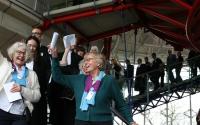12 July 2007Environmental News NetworkKaren Brettell
New York City may seem like an unlikely place to leave bicycles out for people to ride for free, but some activists are hoping residents can learn to share bikes like Europeans to ease congestion and pollution.
A five-day experiment that ended Wednesday allowed New Yorkers to pedal around at no cost for up to 30 minutes in a prelude to what organizers hope will become a permanent program.
With hot, humid weather blanketing the city this week, some 30 people a day were borrowing the bikes for test rides, organizers said. More people visited an exhibit posted by two nonprofit groups in Manhattan to learn about the program.
The groups, the Storefront for Art and Architecture and the Forum for Urban Design, say a bike-sharing program would help the environment and reduce congestion on busy streets.
Under the proposal, bicycles would be available at locations throughout the city. The first half-hour would be free and additional time available at a minimum cost.
Cyclist Bambi Bogert, 40, a free-lance journalist looking at the exhibit this week, said she liked the proposal but hoped the city would work to improve safety.
"It's a very difficult city to bike in," she said. "I come close to getting hit several times a day."
The largest bike-sharing program is in Paris, where 10,000 bicycles are available at some 750 locations across the city for a nominal charge.
Bike-sharing also has been set up in Stockholm, Oslo, Copenhagen and Frankfurt as well as in Lyon, France, and Barcelona and Pamplona, Spain. San Francisco is setting up the first major U.S. system.
"The idea here is to give New Yorkers a very clear and splashy understanding of how these programs already work in Europe," said David Haskell, executive director of the Forum for Urban Design.
"Bike sharing is a total reality, not an urban designer's fantasy," he said.
One way of getting a program up and running would be to find sponsors who could install advertisements on the bicycles, organizers said.
The bikes in cities that have sharing programs are built to allow advertising. They also are painted conspicuous colors and have some components, like pedals, that do not fit normal bicycles to discourage thieves.
The city government would need to support the program as well by installing bicycle pick-up spots and additional bicycle lanes, the organizers said.
City officials are studying the bike-sharing program and watching how the San Francisco program develops, said Molly Gordy, a spokeswoman for the Department of Transportation. The city also is planning to designate additional bicycle lanes in the streets, she said.






